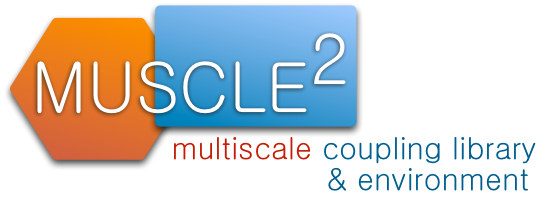| Version 2 (modified by jorisborgdorff, 11 years ago) (diff) |
|---|
Publications
The following publication should be cited when using MUSCLE 2:
- Borgdorff, M. Mamonski, B. Bosak, K. Kurowski, M. Ben Belgacem, B. Chopard, et al., Distributed multiscale computing with MUSCLE 2, the Multiscale Coupling Library and Environment, Journal of Computational Science. 5 (2014) 719–731. doi:10.1016/j.jocs.2014.04.004.
It is based on MUSCLE 1 (previously called DSCL):
- Hegewald, M. Krafczyk, J. Tölke, A.G. Hoekstra, An agent-based coupling platform for complex automata, in: Iccs 2008, Lncs 5102, 2008: pp. 227–233. doi:10.1007/978-3-540-69387-1_25.
The theory and formalization that lies at the basis of MUSCLE is formed by the Multiscale Modelling and Simulation Framework. It is explained here:
- Borgdorff, J.-L. Falcone, E. Lorenz, C. Bona-Casas, B. Chopard, A.G. Hoekstra, Foundations of distributed multiscale computing: Formalization, specification, and analysis, Journal of Parallel and Distributed Computing. 73 (2013) 465–483. doi:10.1016/j.jpdc.2012.12.011.
- Chopard, J. Borgdorff, A.G. Hoekstra, A framework for multi-scale modelling, Philosophical Transactions of the Royal Society A: Mathematical, Physical and Engineering Sciences. 372 (2014). doi:10.1098/rsta.2013.0378.
- Ben Belgacem, B. Chopard, J. Borgdorff, M. Mamonski, K. Rycerz, D. Harezlak, Distributed Multiscale Computations Using the MAPPER Framework, Procedia Computer Science. 18 (2013) 1106–1115. doi:10.1016/j.procs.2013.05.276.
The following applications are known to use MUSCLE 2 (if you are also using MUSCLE, please let us know and we can add you to the list):
An overview of applications using distributed multiscale computing:
- Borgdorff, M. Ben Belgacem, C. Bona-Casas, L. Fazendeiro, D. Groen, O. Hoenen, et al., Performance of distributed multiscale simulations, Philosophical Transactions of the Royal Society A: Mathematical, Physical and Engineering Sciences. 372 (2014). doi:10.1098/rsta.2013.0407.
In-stent restenosis (ISR3D):
- Borgdorff, C. Bona-Casas, M. Mamonski, K. Kurowski, T. Piontek, B. Bosak, et al., A Distributed Multiscale Computation of a Tightly Coupled Model Using the Multiscale Modeling Language, Procedia Computer Science. 9 (2012) 596–605. doi:10.1016/j.procs.2012.04.064.
- Groen, J. Borgdorff, C. Bona-Casas, J. Hetherington, R.W. Nash, S.J. Zasada, et al., Flexible composition and execution of high performance, high fidelity multiscale biomedical simulations, Interface Focus. 3 (2013) 20120087. doi:10.1098/rsfs.2012.0087.
Canal system simulation:
- Ben Belgacem, B. Chopard, A. Parmigiani, Coupling Method for Building a Network of Irrigation Canals on a Distributed Computing Environment, in: G.C. Sirakoulis, S. Bandini (Eds.), 7495 ed., Springer-Verlag Berlin Heidelberg, 2012: pp. 309–318. doi:10.1007/978-3-642-33350-7_32.
Tokamak reactor turbulence transport:
- Hoenen, L. Fazendeiro, B.D. Scott, J. Borgdorff, A.G. Hoekstra, P. Strand, et al., Designing and running turbulence transport simulations using a distributed multiscale computing approach, in: EPS 2013, Europhysics Conference Abstracts, 37D, Espoo, Finland, 2013: p. P4.155.
Reverse-engineering of gene-regulatory networks:
- Mizeranschi, N. Kennedy, P. Thompson, H. Zheng, W. Dubitzky, The Influence of Network Topology on Reverse-engineering of Gene-regulatory Networks, Procedia Computer Science. 29 (2014) 410–421. doi:10.1016/j.procs.2014.05.037.
